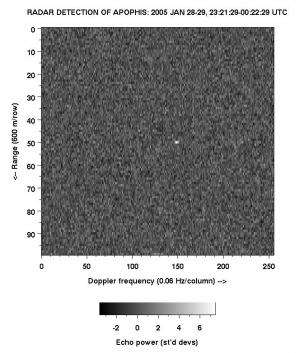October 30, 2014 report
Asteroid Apophis could experience landslides when it passes near Earth

(Phys.org) —A team of space scientists with members from the U.S., China and France has found via computer modeling that an asteroid due to pass close to Earth in 2029 is likely to experience minor landslides. In their paper published in the journal Icarus, the researchers describe the data they input into their model and what the simulation showed.
Asteroid Apophis (99942) is due to pass within 35,000 kilometers of Earth, on Friday, April 13th, 2029 (talk about an unlucky day), though all signs suggest that's as close it will come—no collision is expected. But what sort of effect will the passing have on the asteroid due to the Earth's gravity? That's what the team with this latest effort sought to learn.
The researchers didn't have photographic evidence of the asteroid, but they did have something close—photographs of asteroid Itokawa, taken by Hayabusa, a Japanese spacecraft—the two are close in size (roughly that of a football field) and might be similar in composition. The pictures of Itokawa showed that the asteroid wasn't a single rock, but was instead a mass of rocks of varying sizes clinging together due to their gravitational pull. If Apophis has roughly the same makeup, the researchers reasoned, than it would seem likely that some of the rocks would be moved by Earth's gravitational pull as the two come close together. To find out if that might be possible they constructed a computer simulation that took into account not only Earth's gravitational pull, but that of Apophis as well—and also centrifugal force from the rotation of the asteroid, inertial forces and other factors they felt would likely come into play.
The simulation showed that it was likely that Apophis would experience slow, gentle landslides, as smaller loose rocks moved along its surface. And if that happens, it would offer scientists observing the asteroid some new information about its age. Space scientists analyze the light that is bounced back by asteroids to calculate how old they are. If Apophis experiences landslides, that would mean a thin layer of the surface would be removed, revealing what lies below—offering a new perspective on the asteroid aging process.
More information: Numerical predictions of surface effects during the 2029 close approach of Asteroid 99942 Apophis, Icarus, Volume 242, 1 November 2014, Pages 82–96. DOI: 10.1016/j.icarus.2014.07.027 . On Arxiv: http://arxiv.org/abs/1408.0168
Abstract
Asteroid (99942) Apophis' close approach in 2029 will be one of the most significant small-body encounter events in the near future and offers a good opportunity for in situ exploration to determine the asteroid's surface properties and measure any tidal effects that might alter its regolith configuration. Resurfacing mechanics has become a new focus for asteroid researchers due to its important implications for interpreting surface observations, including space weathering effects. This paper provides a prediction for the tidal effects during the 2029 encounter, with an emphasis on whether surface refreshing due to regolith movement will occur. The potential shape modification of the object due to the tidal encounter is first confirmed to be negligibly small with systematic simulations, thus only the external perturbations are taken into account for this work (despite this, seismic shaking induced by shifting blocks might still play a weak role and we will look into this mechanism in future work). A two-stage approach is developed to model the responses of asteroid surface particles (the regolith) based on the soft-sphere implementation of the parallel N-body gravity tree code pkdgrav. A full-body model of Apophis is sent past the Earth on the predicted trajectory to generate the data of all forces acting at a target point on the surface. A sandpile constructed in the local frame is then used to approximate the regolith materials; all the forces the sandpile feels during the encounter are imposed as external perturbations to mimic the regolith's behavior in the full scenario. The local mechanical environment on the asteroid surface is represented in detail, leading to an estimation of the change in global surface environment due to the encounter. Typical patterns of perturbation are presented that depend on the asteroid orientation and sense of rotation at perigee. We find that catastrophic avalanches of regolith materials may not occur during the 2029 encounter due to the small level of tidal perturbation, although slight landslides might still be triggered in positions where a sandpile's structure is weak. Simulations are performed at different locations on Apophis' surface and with different body- and spin-axis orientations; the results show that the small-scale avalanches are widely distributed and manifest independently of the asteroid orientation and the sandpile location. We also include simulation results of much closer encounters of the Apophis with Earth than what is predicted to occur in 2029, showing that much more drastic resurfacing takes place in these cases.
Journal information: Icarus
© 2014 Phys.org



















